Multiple Choice
Identify the
choice that best completes the statement or answers the question.
|
|
|
HUMAN RIGHTS
In the era of détente, the issue of human rights
gained attention on both sides of the Iron Curtain. In 1975 in Helsinki, 35 nations -- including the
United States and U.S.S.R. -- signed a declaration on human rights. Meanwhile, Czech dissidents
secretly drew up Charter 77, a human rights document that was smuggled to the West. Activists in the
communist bloc set up Helsinki Watch Committees to monitor and publicize abuses. But the Soviets did
not feel bound by the Helsinki Accords and persecuted the dissidents, many of whom ended up in KGB
prisons -- or in mental hospitals, where mind-control drugs were used to make them recant.
Jews
were a distinctive group among the dissidents -- claiming the right to leave the Soviet Union. Many
were refused exit visas and became known as refuseniks. Those who campaigned for their rights were
often sent to forced labor camps for years. In 1979, the prominent refusenik Anatoly Sharansky was
sentenced to 13 years for espionage and treason. Outside the court, supporters defiantly publicized
his case to the Western media -- triggering forceful protests in the West. The evidence of human
rights abuse inflamed anti-Soviet feeling in America.
|
| | |
|
|
|
1.
|
What were the Helsinki Watch Committees?
a. | Groups set up in the West to monitor
human rights abuses by the U.S. | c. | Groups set up in the to monitor anti-Soviet activities by
Jews | b. | Groups set up in the West to monitor human rights abuses by the
Soviets | d. | Committees that helped the KGB to monitor treasonous
activity |
|
|
|
2.
|
Which ethnic group was
especially targeted by the Soviet KGB for treasonous activity?
a. | Slavs | c. | Jews | b. | Americans | d. | Christians |
|
|
|
SALT II
As Moscow and Washington clashed over human rights, they
also stepped up negotiations for a new arms limitation treaty -- SALT II.
One issue
not on the SALT II agenda was
the Soviets' decision to deploy the SS-20, a new medium-range nuclear missile that targeted
Western Europe. West Germany and other NATO allies were alarmed. Instead of making the SS-20s an
issue during the SALT II negotiations, the United States pursued a twin-track policy: America would
develop its new generation of missiles and allow Moscow three years to negotiate limits on
medium-range missiles. If no deal was reached, America would station its cruise and Pershing nuclear
missiles in Europe -- and target Soviet cities. Fear of missiles in their backyard created a new mood
of resistance among Western Europeans.
By June 1979, the superpowers had agreed to new limits on
strategic arms -- completing the SALT II treaty. Carter and Brezhnev met for the first time when they
came to Vienna to sign the agreement. Soviets viewed the treaty as a way to limit arms production --
and improve their civilian economy. But in America, the pact was condemned by the political right
for
| 
The Democrat
controlled congress and much of the American public thought the SALT II treaty was not good for the
U.S.
not
imposing limits on the development of new weapons systems. Ultimately, SALT II would fail to gain
congressional approval even though the congress was controlled by President Carter’s own party,
the Democrats. | | |
|
|
|
3.
|
The purpose of SALT II was
to
a. | Increase trade between the U.S. and
Soviets | c. | Improve cultural
contacts between the U.S. and the Soviets | b. | reduce nuclear arms between the U.S. and the Soviet
Union | d. | Drive a wedge between Russia and
China |
|
|
|
4.
|
SALT II
was
a. | a new treaty between the U.S. and
the Soviets enacted into law in the U.S. | c. | a defeat for President Carter | b. | a congressionally approved attempt to limit U.S. nuclear
arms | d. | a success for President
Carter |
|
|
|
5.
|
SALT II was signed by
a. | Carter and Brezhnev
| c. | Reagan and
Gorbachev | b. | Carter and Andropov | d. | Carter and Gorbachev |
|
|
|
Ronald Reagan had a different philosophy and approach to communism than
President Jimmy Carter. In 1981, Ronald Reagan -- a strident Cold Warrior -- enters the White House
on a platform of "making America strong again." Convinced the United States is lagging in
the arms race, Reagan increases defense spending and proposes a "Star Wars" anti-missile
system -- alarming leaders in Moscow.
Reagan reasoned that he could increase the chances of peace
by eliminating the threat of a nuclear attack by the Soviets. He offered to share the technology with
the Soviets.
| | | |
|
|
|
6.
|
From the passage we can infer
that Ronald Reagan was
a. | a pro-Soviet
president | c. | a moderate
regarding communism | b. | a strong anti-communist | d. | a president with socialist
tendencies |
|
|
|
7.
|
The Soviets were most likely
a. | more afraid of Carter than
Reagan | c. | equally fearful of Carter and
Reagan | b. | more afraid of Reagan than Carter | d. | not very concerned with Carter of
Reagan |
|
|
|
REAGAN
At his first press conference as president, Ronald Reagan rendered a tough
verdict on the policy of détente, calling it "a one-way street the Soviet Union has used to
pursue its own aims." Reagan's message was unmistakable: The only way to deal with the
Kremlin was from a position of strength.
Immediately, he began a new phase of rearmament. He
increased the defense budget by $32.6 billion. He approved production of the costly B-1 bomber, a
project President Carter had scrapped. He expanded the size of the Navy. And new defense guidelines
called for preparations to wage a nuclear war "over a protracted period."
| The renewed arms race and Reagan's anti-Soviet
rhetoric revived the anti-nuclear movement in Western Europe. Reagan was portrayed by a vocal
minority of Americans and many Europeans as a warmonger. Yet, in truth, Reagan shared their antipathy
for nuclear brinksmanship -- the policy known as "mutual assured destruction."
| | |
|
|
|
8.
|
In dealing with the Soviets,
Reagan believed the U.S. needed to deal from a position of strength. What did he do to make America
stronger?
a. | Spent money to make the U.S.
military the most powerful in the world. | c. | Spent more money on social programs like
Medicare | b. | Spent more money on education | d. | Made the U.S. work more with the United
Nations |
|
|
|
9.
|
Which idea was most likely
believed by Reagan?
a. | It is more important that your enemy
like you than respect you | c. | Do not do anything to make your enemies
upset | b. | If you are nice to your enemies they will be nice to
you | d. | It is more important to be respected than
loved. |
|
|
|
10.
|
How did Reagan feel about MAD
(mutual assured destruction)
a. | was in favor of
it | c. | was unconcerned about
it | b. | was opposed to
it | d. | did not know what it
was |
|
|
|
TENSION
In Moscow, Andropov (leader of the Soviet Union) responded
defiantly to Reagan's "Star Wars" plan. "All attempts at achieving military
superiority over the U.S.S.R. are futile," he said. Privately, however, Andropov was frightened
by SDI and Reagan's anti-Soviet speeches. In one of his speeches Reagan called the Soviet Union
the, “Evil Empire.” Convinced that the West was planning for war, Andropov ordered a
worldwide alert. The KGB monitored every aspect of life in the West.
The Americans stepped up spy
flights in sensitive areas along the Soviet Union's long borders. Aircraft packed with
electronic surveillance gear and disguised as civilian airliners often flew close to passenger
routes.
On August 31, 1983, a South Korean airliner left Anchorage for Seoul. For reasons still
unexplained, KAL Flight 007, with 269 people on board, ended up in Soviet air space, more than 300
miles from its normal route. Every indication was that the airliner was a civilian plane. After
firing several warning tracer shots across the plane's bow, a Soviet fighter pilot downed the
carrier, killing everyone on board. Reagan called the incident "an act of barbarism." The
American people, and the people of the world were outraged.
| 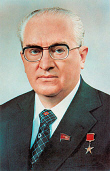
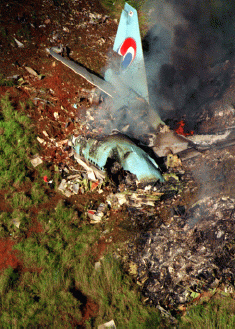 | | |
|
|
|
11.
|
It is safe to say that the
Soviets and Andropov were
a. | unconcerned about the U.S. and
Reagan | c. | unconcerned about the U.S. because
they had weapons just as good as the U.S. | b. | alarmed by Reagan and his
policies | d. | concerned about American policies
but liked and trusted Ronald Reagan |
|
|
|
12.
|
The shooting down of flight KAL
007
a. | helped to prove Reagan’s
statement that the Soviet Union was an evil empire | c. | improved relations between South Korea and the Soviet
Union | b. | made the American people more sympathetic towards the Soviets because it was a
mistake | d. | made people more fearful of Soviet technology
|
|
|
|
13.
|
KAL 007 was a civilian airliner
belonging to _____ shot down by _____
a. | the United States - the Soviet
Union | c. | North Korea -
China | b. | the United States - China | d. | South Korea - the Soviet Union |
|
|
|
GORBACHEV
A mood of crisis now gripped both East and West. Arms
control talks were broken off. The Soviet leadership even believed a nuclear attack by the West was
imminent. Reagan was surprised when told the Kremlin seriously feared an American first-strike
offensive. It was time, he told aides, for a face-to-face meeting with Soviet leaders.
But to
whom in the Kremlin could Reagan talk peace? In February 1984, Yuri Andropov died. His successor,
Konstantin Chernenko, was too frail to start a dialogue and died a year later -- the third aged
Soviet leader to die in three years.
Party leaders knew the country needed new blood. They turned
to 54-year-old reformer Mikhail Gorbachev -- who in a speech the year before had introduced the
concepts of "perestroika" (restructuring) and "glasnost" (openness) to the
Communist Party lexicon. At a party plenum to ratify his election by the Politburo, Gorbachev pledged
to make the Soviet Union more democratic -- and announced his intention to stop the arms
race.
| 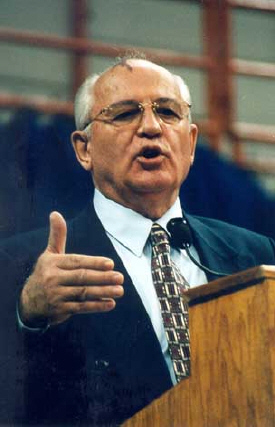 | | |
|
|
|
14.
|
The Soviets
were
a. | not afraid of the U.S. under
Reagan | c. | afraid of Reagan but sure he would
not attack the Soviet Union | b. | afraid the U.S. under Reagan might attack the Soviet
Union | d. | more concerned about domestic issues than foreign
affairs |
|
|
|
15.
|
Why did Reagan want a face to
face meeting with the leader of the Soviet Union?
a. | spy on the Soviet
Union | c. | ease tensions between the two
countries | b. | to get trade concessions from the Soviets | d. | warn the Soviets that the U.S. might attack at any
time |
|
|
|
16.
|
What Soviet leader started the
idea of perestroika" (restructuring) and "glasnost"
(openness)
a. | Andropov | c. | Gorbachev
| b. | Khrushchev | d. | Brezhnev |
|
|
|
RAPPORT
In November 1985, Gorbachev traveled to Geneva to meet
with Reagan for the first superpower summit in six years.
At their first face-to-face meeting,
the two leaders outlined their positions in adversarial terms -- arguing about regional conflicts and
accusing each other of trying to divide the world. Gorbachev later told aides Reagan was not just a
conservative, but "a political dinosaur." Later that day, the tenor of the dialogue
changed. Though the two leaders remained divided by Reagan's "Star Wars" initiative,
the atmosphere grew warmer -- they established a rapport. Gorbachev left Geneva without agreement on
his main objective -- curbing the arms race -- but the United States and the Soviet Union were
talking again.
One year into the Gorbachev era the Cold War continued. The Geneva call for a
second summit was repeatedly postponed. Fears of nuclear war remained. In April 1986, an explosion
ripped apart a reactor at the Chernobyl nuclear power plant in Ukraine north of Kiev. The disaster
highlighted the incompetence of the Soviet system. The Soviets were weak economically,
scientifically, and their infrastructure was poor.
| 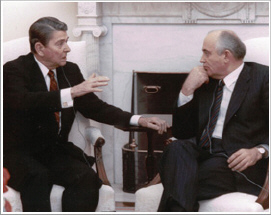
Personal Friendship develops between Reagan and
Gorbachev
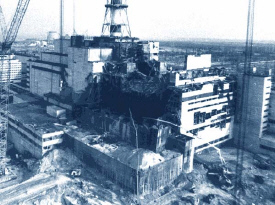 Soviet Powerplant at Chernobyl explodes killing thousands and spreading radiation
throughout Europe Soviet Powerplant at Chernobyl explodes killing thousands and spreading radiation
throughout Europe | | |
|
|
|
17.
|
What was the main result of the
first meeting between Reagan and Gorbachev at Geneva in
1985?
a. | Reagan and Gorbachev confirmed that they could not trust each other | c. | Gorbachev became convinced that he could manipulate Reagan
any way he wanted. | b. | A new arms reduction treaty was agreed to by the Soviets and the
U.S. | d. | The two men established a rapport and a basis for trust
between them |
|
|
|
18.
|
In the 1985 Geneva summit,
Reagan and Gorbachev learned to _____ each other.
a. | respect | c. | distrust | b. | hate | d. | fear |
|
|
|
19.
|
What happened at Chernobyl ?
a. | Soviet nuclear missile
exploded | c. | Ukrainian water
power plant exploded | b. | Soviet nuclear power plant exploded | d. | The U.S. attacked a Ukrainian power
plant |
|
|
|
20.
|
What did Chernobyl illustrate to the world?
a. | Strength of the Soviet
economy | c. | The power of the
Soviet infrastructure | b. | Serious weaknesses in all phases of Soviet
society | d. | The power of Soviet Science and
technology |
|
|
|
REYKJAVIK
Six months after the Chernobyl disaster, Reagan and
Gorbachev went to Reykjavik, Iceland, for their second summit. No one expected much of substance to
emerge.
But over the next few days, the two leaders took a series of bold and unexpected steps
aimed at reducing the threat of nuclear war. Gorbachev seized the initiative, winning Reagan's
backing for a comprehensive set of reductions of strategic arms, intermediate-range missile and space
weapons. Next, the two leaders agreed on the complete withdrawal of intermediate-range missiles in
Europe and a 50 percent reduction in ballistic missiles over a five-year period.
As the talks
continued, Reagan and Gorbachev each raised the ante in their quest for arms reductions. Finally,
Reagan stunned Gorbachev and his own advisers by offering to eliminate all nuclear weapons in 10
years, effectively abolishing the nuclear deterrent. But Gorbachev continued to press Reagan on
"Star Wars." "Our meeting cannot produce one winner. We both either win or lose,"
he said. Reagan would not budge.
The summit ended without an agreement -- but each delegation
realized the discussions had crossed a historic line. In 1987, Reagan and
| 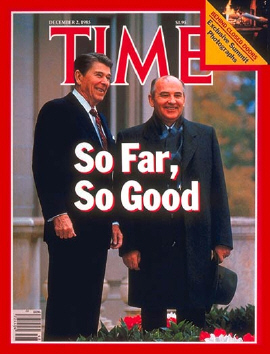
Gorbachev met in Washington to sign the Intermediate-range Nuclear Forces (INF)
Treaty -- eliminating an entire class of U.S. and Soviet nuclear arms for Eastern and Western Europe.
Reagan's defense of "Star Wars" prevented further progress in arms talks for the
remainder of his presidency. Nevertheless, two leaders a generation apart had brought their two
countries closer then they had been in 40 years. | | |
|
|
|
21.
|
At Reykjavik, Iceland, Reagan and Gorbachev
a. | laid the foundation for a series of
major arms reduction measures | c. | could not agree on any arms reduction
measures | b. | agreed to develop “star wars”
together. | d. | left angry and distrustful of each
other. |
|
|
|
22.
|
What was the big surprise
proposal made by Reagan at the Reykjavik, Iceland
summit?
a. | that Reagan would be NICE to the
Soviet Union from now on and stop calling them names. | c. | that the U.S. was willing to end Star Wars | b. | Reagan made no surprise
proposal | d. | that both nations would eliminate
ALL nuclear arms |
|
|
|
23.
|
Many people in the United
States and Europe thought that Star Wars was a fantasy and could not be achieved. How did the Soviets
feel about Star Wars?
a. | They were afraid of
it | c. | They did not concern themselves with
it | b. | They agreed that it was a
fantasy | d. | All of these are true of the
Soviets |
|
|
|
24.
|
Reagan believed that Star Wars
was protection for the American people against nuclear missile attack. He also knew that if he agreed
with Gorbachev to get rid of Star Wars, he could go down in history as the president who ended the
cold war. Reagan refused to get rid of Star Wars showing that he was _____ president who _____
.
a. | a weak - who would do anything to
become famous | c. | a strong - cared
more for the people than his own legacy | b. | a cruel - who cared little for the American
people. | d. | an evil - who put the destruction of the Soviet Union
ahead of the safety of the American people |
|
|
|
25.
|
Reagan was a strong Republican
conservative. Many people give him credit for winning the cold war because he built up the military
to a point where the Soviets could no longer keep up. Of all the presidents during the cold war, it
was Reagan who came up with the bold ideas that finally ended the cold war. Gorbachev agreed to an
end of the cold war because he trusted Reagan.
|